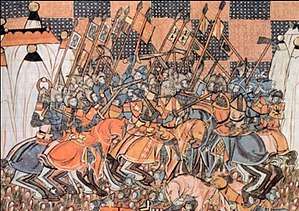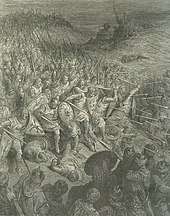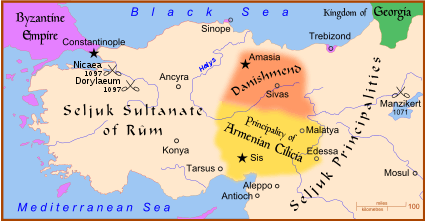Battle of Dorylaeum (1097)
The Battle of Dorylaeum took place during the First Crusade on July 1, 1097, between the crusaders and the Seljuk Turks, near the city of Dorylaeum in Anatolia. Despite Kilij Arslan almost destroying Bohemond's contingent, help arrived just in time for a very close victory.
| Battle of Dorylaeum | |||||||
|---|---|---|---|---|---|---|---|
| Part of the First Crusade | |||||||
 The Battle of Dorylaeum | |||||||
| |||||||
| Belligerents | |||||||
| Crusaders | Sultanate of Rûm | ||||||
| Commanders and leaders | |||||||
|
Bohemond of Taranto Robert II of Normandy Godfrey of Bouillon Adhemar of Le Puy |
Kilij Arslan I Gazi Gümüshtigin | ||||||
| Strength | |||||||
|
Bohemond (vanguard): ~20,000[1] Main force: ~ 30,000[1] (not all engaged) | ~6,000–8,000 horse archers[1][2] | ||||||
| Casualties and losses | |||||||
| ~ 4,000[3] | ~ 3,000[3] | ||||||
| *Perhaps 2,000 knights and 8,000 men at arms, no more than 3,000 knights and 12,000-foot. | |||||||
Background
The crusaders had left Nicaea on June 26, with a deep distrust of the Byzantines, who had taken the city without their knowledge after a long siege. In order to simplify the problem of supplies, the Crusader army had split into two groups; the weaker led by Bohemond of Taranto, his nephew Tancred, Robert Curthose, Robert of Flanders, and the Byzantine general Tatikios in the vanguard, and Godfrey of Bouillon, his brother Baldwin of Boulogne, Raymond IV of Toulouse, Stephen II, and Hugh of Vermandois in the rear.
On June 29, they learnt that the Turks were planning an ambush near Dorylaeum (Bohemond noticed that his army was being shadowed by Turkish scouts). The Turkish force, consisting of Kilij Arslan I and his ally Hasan of Cappadocia, along with help from the Danishmendids, led by the Turkish prince Gazi Gümüshtigin. Contemporary figures place this number between 25,000-30,000, more recent estimates are between 6,000 and 8,000 men.[1][2] Back then numbers were mentioned absurdly high in order to give it a heroic twist, 150,000 men according to Raymond of Aguilers, which was not possible due lack of logistic support, men and since Turks fought a hit and run guerrilla-tactic indicating a small army. Fulcher of Chartres gives the exaggerated number of 360,000.
In addition to large numbers of noncombatants, Bohemond's force probably numbered about 10,000, the majority on foot. Military figures of the time often imply perhaps several men-at-arms per knight (i.e., a stated force of 500 knights is assumed to contain perhaps 1,500 men-at-arms in addition), so it seems reasonable that Bohemond had with him approximately 8,000 men-at-arms and 2,000 cavalry.
On the evening of June 30, after a three-day march, Bohemond's army made camp in a meadow on the north bank of the river Thymbres, near the ruined town of Dorylaeum (Many scholars believe that this is the site of the modern city of Eskişehir).
Battle

On July 1, Bohemond's force was surrounded outside Dorylaeum by Kilij Arslan. Godfrey and Raymond had separated from the vanguard at Leuce, and the Turkish army attacked at dawn, taking Bohemond's army (not expecting such a swift attack) entirely by surprise, shooting arrows into the camp. Bohemond's knights had quickly mounted but their sporadic counterattacks were unable to deter the Turks. The Turks were riding into camp, cutting down noncombatants and unarmoured foot soldiers, who were unable to outrun the Turkish horses and were too disoriented and panic-stricken to form lines of battle. To protect the unarmoured foot and noncombatants, Bohemond ordered his knights to dismount and form a defensive line, and with some trouble gathered the foot soldiers and the noncombatants into the centre of the camp; the women acted as water-carriers throughout the battle. While this formed a battle line and sheltered the more vulnerable men-at-arms and noncombatants, it also gave the Turks free rein to maneuver on the battlefield.
The Turkish mounted archers attacked in their usual style - charging in, shooting their arrows, and quickly retreating before the crusaders could counterattack. The archers did little damage to the heavily armoured knights, but they inflicted heavy casualties on the horses and unarmoured foot soldiers. Bohemond had sent messengers to the other Crusader army and now struggled to hold on until help arrived, and his army was being forced back to the bank of the Thymbris river. The marshy riverbanks protected the crusaders from mounted charge, as the ground was too soft for horses, and the armoured knights formed a circle protecting the foot soldiers and noncombatants from arrows, but the Turks kept their archers constantly supplied and the sheer number of arrows was taking its toll, reportedly more than 2,000 falling to horse-archers. Bohemond's knights were impetuous - although ordered to stand ground, small groups of knights would periodically break ranks and charge, only to be slaughtered or forced back as the Turkish horses fell back beyond range of their swords and arrows, while still shooting at them with arrows, killing many of the knights' horses out from under them. And although the knights' armour protected them well (the Turks called them 'men of iron') the sheer number of arrows meant that some would find unprotected spots and eventually, after so many hits, a knight would collapse from his wounds.

Just after midday, Godfrey arrived with a force of 50 knights, fighting through the Turkish lines to reinforce Bohemond. Through the day small groups of reinforcements (also from Raymond, and Hugh, as well as Godfrey) arrived, some killed by the Turks, others fighting to reach Bohemond's camp. As the Crusader losses mounted, the Turks became more aggressive and the Crusader army found itself forced from the marshy banks of the river into the shallows. But the Crusaders held on, and after approximately 7 hours of battle, Raymond's knights arrived (it is unclear if Raymond was with them, or if they arrived ahead of Raymond), launching a vicious surprise attack across the Turkish flank that turned them back in disarray and allowed the Crusaders to rally.
The Crusaders had formed a line of battle with Bohemond, Tancred, Robert of Normandy, and Stephen on the left wing, Raymond, Robert of Flanders in the centre and Godfrey, Robert of Flanders, and Hugh on the right, and they rallied against the Turks, proclaiming "hodie omnes divites si Deo placet effecti eritis" ("today if it pleases God you will all become rich"). Although the ferocity of the Norman attack took the Turks by surprise, they were unable to dislodge the Turks until a force led by Bishop Adhemar of Le Puy, the Papal legate, arrived in mid-afternoon, perhaps with Raymond in the van, moving around the battle through concealing hills and across the river, outflanking the archers on the left and surprising the Turks from the rear. Adhemar's force fell on the Turkish camp, and attacked the Turks from the rear. The Turks were terrified by the sight of their camp in flames, and by the ferocity and endurance of the knights, since the knights' armour protected them from arrows and even many sword cuts, and they promptly fled, abandoning their camp and forcing Kilij Arslan to withdraw from the battlefield.
Aftermath
The crusaders did indeed become rich, at least for a short time, after capturing Kilij Arslan's treasury. The Turks fled and Arslan turned to other concerns in his eastern territory. Arslan punitively took the male Greek children from the region extending from Dorylaeum to Iconium, sending many as slaves to Persia.[4] On the other hand, the crusaders were allowed to march virtually unopposed through Anatolia on their way to Antioch. It took almost three months to cross Anatolia in the heat of the summer, and in October they began the siege of Antioch.
With the Crusader army moved onwards towards Antioch, the Emperor Alexios I achieved part of his original intent in inviting the Crusaders in the first place: the recovery of Seljuk-held imperial territories in Asia Minor. John Doukas re-established Byzantine rule in Chios, Rhodes, Smyrna, Ephesus, Sardis, and Philadelphia in 1097–1099. This success is ascribed by Alexios' daughter Anna to his policy and diplomacy, but by the Latin historians of the crusade to his treachery and falseness.
The Gesta Francorum did praise the Turkish army's bravery and superhuman efforts at Dorylaeum. It mentioned:
Had the Turks been Christian, they would have been the finest of races.
— [5]
Notes
- John France, The Crusades And The Expansion Of Catholic Christendom, 1000–1714, p. 71 "[...]The result was a gap of about 5 kilometres between the vanguard, consisting of the armies of Bohemond, Robert of Normandy and Stephen of Blois about 20,000 strong, and the main force of about 30,000. They were aware of that Kilij Arslan was about: he had returned to the fray after the defeat of Nicaea, with an army of 6,000-7,000 mounted man, including his new allies, the Danishmend Turks."
- Bennett, The Hutchinson Dictionary of Ancient & Medieval Warfare, p. 103 "Following their successful siege of Nicaea in 1097, the crusaders split into two columns to aid foraging. The vanguard under Bohemond was attacked at Bozüyük. Sultan Kilij Arslan led 7,000-8,000 Seljuk horse archers in an ambush, throwing the crusaders into confusion."
- John France, Victory in the East, p. 181 "Casualties appear to have been heavy although how far we can regard Albert's 4,000 Christians and 3,000 Turks as precise figures is a different matter."
- Jr, [by] Speros Vryonis (1971). The decline of medieval Hellenism in Asia Minor and the process of Islamization from the eleventh through the fifteenth century. Berkeley: University of California Press. p. 175. ISBN 9780520015975.
- Steven Runciman, ‘The First Crusade’, (New York: Cambridge University Press, 2005), p. 95
Sources
- Albert of Aix, Historia Hierosolymitana
- Fulcher of Chartres, Historia Hierosolymitana
- Gesta Francorum
- Hans E. Mayer, The Crusades. Oxford, 1965.
- Raymond of Aguilers, Historia francorum qui ceperunt Jerusalem
- Jonathan Riley-Smith, The First Crusade and the Idea of Crusading. Philadelphia, 1999.
- Runciman, Steven (1951). A History of the Crusades, Volume I: The First Crusade and the Foundation of the Kingdom of Jerusalem. Cambridge: Cambridge University Press.
- Setton, Kenneth M.; Baldwin, Marshall W., eds. (1969) [1955]. A History of the Crusades, Volume I: The First Hundred Years (Second ed.). Madison, Milwaukee, and London: University of Wisconsin Press. ISBN 0-299-04834-9.
- John France, Victory in the East: A Military History of the First Crusade, Cambridge University Press, 1996.
- John France, The Crusades And The Expansion Of Catholic Christendom, 1000–1714, Routledge, 2005.
- Matthew Bennett, The Hutchinson Dictionary of Ancient & Medieval Warfare, Helicon Publishing Ltd, 1998.